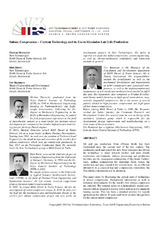| dc.contributor.other | Turbomachinery Symposium (45th : 2016) | |
| dc.creator | Dettwyler, Markus | |
| dc.creator | Büche, Dirk | |
| dc.creator | Baumann, Urs | |
| dc.date.accessioned | 2017-03-14T21:29:14Z | |
| dc.date.available | 2017-03-14T21:29:14Z | |
| dc.date.issued | 2016 | |
| dc.identifier.uri | https://hdl.handle.net/1969.1/159799 | |
| dc.description | Tutorial | en |
| dc.description.abstract | Oil and gas production from offshore fields has been established since the second half of the last century. The continuous need and search for new fossil resources has driven the technology to adapt towards harsher and more hostile exploration environments. Subsea processing and production facilities are the consequent continuation of this trend. Further- more, adding compression for depleting fields boosts the production and may extend it for several years. As an efficient alternative to a classical top-side compression installation, the first subsea compressors are in operation. This paper starts by illustrating the current state of technology in subsea compression. Background information as well as historical developments for the world’s first subsea compressor are outlined. The concept relies on a hermetically-sealed com- pressor with an integrated electric motor and an active magnetic bearing system. This has been a standard solution for topside applications for almost 30 years and forms an ideal design basis for the subsea motor-compressor. In a second step, different approaches for multiphase subsea compression are compared. These are (1) separate compression and pumping of gas and liquid phases, (2) well-stream compression, and (3) multiphase pumping. Limitations of the concepts are outlined. While for compressors, well-streams are typically characterized by the liquid mass fraction (LMF), pumping literature uses gas volume fraction (GVF). The relation between the two parameters is discussed as well as their influence on compression/pumping. Finally, an example of late life gas field production is given. The evolution of the required compression and pumping is estimated and the importance of the compressor selection in maximizing total field recovery is discussed. | en |
| dc.format.medium | Electronic | en |
| dc.format.mimetype | application/pdf | |
| dc.language.iso | en | |
| dc.publisher | Turbomachinery Laboratories, Texas A&M Engineering Experiment Station | |
| dc.relation.ispartof | Proceedings of the 45th Turbomachinery Symposium | en |
| dc.subject.lcsh | Turbomachines | en |
| dc.title | Subsea Compression - Current Technology and its Use to Maximize Late Life Production | en |
| dc.type.genre | Presentation | en |
| dc.type.material | Text | en |
| dc.format.digitalOrigin | born digital | en |
| dc.identifier.doi | https://doi.org/10.21423/R1Z593 | |


